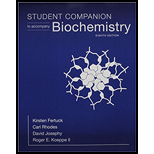
(a)
Interpretation:
6-phosphoglucono-⏹-lactone should be identified.
Concept introduction:
6-phosphoglucono-⏹-lactone is formed during the pentose phosphate pathway. In the first step of pentose phosphate pathway, dehydrogenation of glucose-6-phosphate at C-1 takes produce 6-phosphoglucono-⏹-lactone.
Answer to Problem 21P
The compound C in the reaction is 6-phosphoglucono-⏹-lactone.
Explanation of Solution
6-phosphoglucono-⏹-lactone is an intramolecular ester formed by the reaction of C-1 carboxyl group and C-5 hydroxyl group. It is formed by dehydrogenation of C-1 carbon of Glucose-6-phosphate. Hydroxyl group at C-1 of glucose-6-phosphate is converted to carbonyl group. Therefore, the structure of 6-phosphoglucono-⏹-lactone is (C).
(b)
Interpretation:
The reactions producing NADPH should be determined.
Concept introduction:
Two molecules of NADPH are produced duringthe oxidative phase of pentose phosphate pathway.
Answer to Problem 21P
The reactions B and F produce NADPH.
Explanation of Solution
First NADPH is produced when the C-1 in glucose-6-phosphate is dehydrogenated into 6-phosphoglucono-⏹-lactone by glucose-6-phosphate dehydrogenase. This 6-phosphoglucono-⏹-lactone is hydrolyzed by a lactonase resulting 6-phosphogluconate. This 6C sugar acid is then decarboxylated by 6-phosphogluconate dehydrogenase into ribulose-5-phosphate. In this step also NADP+ acts as the electron acceptor and produce NADPH.

Therefore,reactions B and F produces NADPH.
(c)
Interpretation:
Ribulose-5-phosphate should be identified.
Concept introduction:
Ribulose-5-phosphate is the productof pentose phosphate pathway.
Answer to Problem 21P
The compound G in the reaction is Ribulose-5-phosphate.
Explanation of Solution
As the first step of oxidative phase of pentose phosphate pathway, C-1 of glucose-6-phosphate is dehydrogenated into 6-phosphoglucono-⏹-lactone by glucose-6-phosphate dehydrogenase. Then this 6-phosphoglucono-⏹-lactone is hydrolyzed by a lactonase resulting 6-phosphogluconate. This 6 C sugar acid is then decarboxylated by 6-phosphogluconate dehydrogenase into ribulose-5-phosphate.
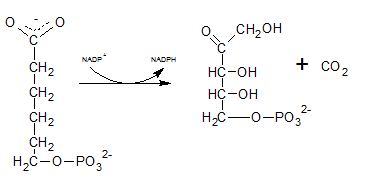
Therefore, Gis Ribulose-5-phosphate.
(d)
Interpretation:
The CO2generating reaction should be determined.
Concept introduction:
The decarboxylation reactions generate CO2 as a by-product.
Answer to Problem 21P
The reactions F produce CO2.
Explanation of Solution
The six C sugar acid, 6-phosphogluconate formed during pentose phosphate pathway is oxidatively decarboxylated by 6-phosphogluconate dehydrogenase into ribulose-5-phosphate. The final product is a five-carbon sugar, and release CO2.

So. the reaction F produce CO2.
(e)
Interpretation:
6-phosphogluconate should be identified.
Concept introduction:
6-phosphogluconate is a 6C sugar acid which forms during pentose phosphate pathway.
Answer to Problem 21P
The compound E in the reaction is 6-phosphogluconate.
Explanation of Solution
In the first step of the oxidative phase of pentose phosphate pathway, C-1 of glucose-6-phosphate is dehydrogenated into 6-phosphoglucono-⏹-lactone by glucose-6-phosphate dehydrogenase which is hydrolyzed by a lactonase resulting 6-phosphogluconate.
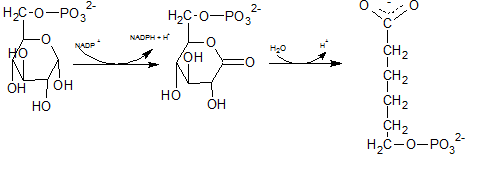
The end product of above reaction is 6-phosphogluconate. Thus the compound E in the reaction is 6-phosphogluconate.
(f)
Interpretation:
The reaction that is catalyzed by phosphopentose isomerase should be determined.
Concept introduction:
Phosphopentose isomerase is an enzyme which involves in isomerization reaction.
Answer to Problem 21P
The reactions H uses Phosphopentose isomerase enzyme.
Explanation of Solution
Ribulose-5-phosphate is isomerized to ribose-5-phosphate by phosphopentose isomerase. The enzyme, phosphopentose isomerase catalyze the conversion of a ketose sugar (Ribulose-5-phosphate ) to an aldose sugar (ribose-5-phosphate).
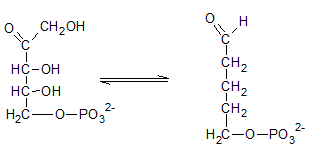
Therefore, the reaction H needs the enzyme phosphopentose isomerase.
(g)
Interpretation:
Ribose-5-phosphate should be identified.
Concept introduction:
Ribose-5-phosphate is the end product of the oxidative phase of pentose phosphate pathway.
Answer to Problem 21P
The compound I in the reaction is Ribose-5-phosphate.
Explanation of Solution
The ribulose-5-phosphate is obtained in pentose phosphate pathway when the ribose-5-phosphate is isomerized by phosphopentose isomerase.
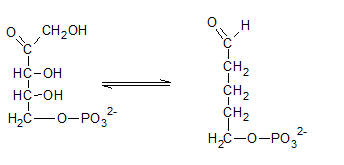
Therefore, the compound I in the reaction is Ribose-5-phosphate.
(h)
Interpretation:
Reaction catalyzed by lactonase should be determined.
Concept introduction:
Lactonases catalyzes the hydrolysis of ester bonds.
Answer to Problem 21P
The reactions D uses the enzymeLactonases.
Explanation of Solution
The degydrogenated product of glucose-6-phospahte is 6-phosphoglucono-⏹-lactone. This is a 6 membered ring structure and have an ester bond between C-1 carbonyl carbon and C-5 hydroxyl Oxygen. This bond is hydrolyzed by lactonase and to produce 6-phosphogluconate. The reaction is indicated by letter D.
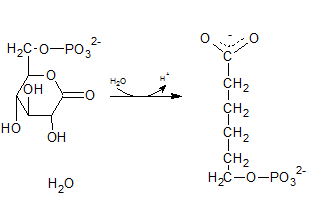
(i)
Interpretation:
Glucose-6-phosphate should be identified.
Concept introduction:
The pentose phosphate pathway is initiated by the oxidation of glucose-6-phosphate.
Answer to Problem 21P
The compound A in the reaction is glucose-6-phosphate.
Explanation of Solution
Glucose-6-phosphate is a 6-carbon sugar and have a ring structure where the hydroxyl group at C-6 is phosphorylated.
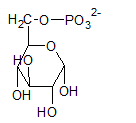
The compound A in the reaction is glucose-6-phosphate.
(j)
Interpretation:
The reaction catalyzed by 6-phosphogluconate dehydrogenase should be determined.
Concept introduction:
Dehydrogenases are the enzymes which catalyzes the removal of hydrogen molecules with the help of coenzymes NAD and FAD.
Answer to Problem 21P
The reactions F uses the enzymedehydrogenases.
Explanation of Solution
6-phosphogluconate is oxidatively decarboxylated by 6-phosphogluconate dehydrogenase into ribulose-5-phosphate which is indicated by reaction F.

(k)
Interpretation:
Reaction that is catalyzed by glucose-6-phosphate dehydrogenase should be determined.
Concept introduction:
In the first reaction of pentose phosphate pathway glucose-6-phosphate is dehydrogenated to produce phosphoglucono-⏹-lactone.
Answer to Problem 21P
The reactions B uses the enzymeglucose-6-phosphate dehydrogenases.
Explanation of Solution
In the first step of pentose phosphate pathway, Glucose-6-phosphate is dehydrogenated at C-1 by glucose-6-phosphate dehydrogenase enzyme into 6-phosphoglucono-⏹-lactone.
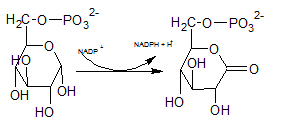
So, the reactions B uses the enzymeglucose-6-phosphate dehydrogenases.
Want to see more full solutions like this?
Chapter 20 Solutions
Student Companion for Biochemistry
- Give explanation Thank you Which form of fructose ,alpha or beta does take part in most biochemical reactionsarrow_forwardMetabolic Classification What type of metabolic reaction is shown by the following reactions? Choices: Amphibolic Anabolic Catabolicarrow_forwardChemistry Please, explain and write about what type of evidence, biochemically, led to the cyclic nature of the glyoxylate pathway?arrow_forward
- BIOMOLECULES - Please answer the questions properly. - Multiple choice 1. Supposed you used the enzyme lyase in the biomolecular laboratory, identify reaction that you have certainly observed with the enzyme Lyase. A. you observed breaking of bonds B. you observed formation of bonds C. you observed intramolecular rearrangement of bonds D. you observed a transfer group from one molecule to another 2. Comprehend the following statements and identify the one that accurately describes an allosteric enzyme. A. It is versatile, in that it can act as either an anabolic enzyme or a catabolic enzyme B. It is regulated by binding to small molecules other than its substrate C. It operates most optimally in a basic environment D. It operates most optimally in an acidic environmentarrow_forwardBIOMOLECULES - MULTIPLE CHOICE - Please answer properly QUESTION : In human beings, what is the major control of de novo pyrimidine nucleotide synthesis? A. substrate availability B. competitive inhibition of carbamoyl phosphate synthetase II C. feedback inhibition of glutamine-PRPP amidotransferase D. vailability of N-acetyl glutamatearrow_forwardBIOMOLECULES - MULTIPLE CHOICE - Please answer properly QUESTION : Supposed you want to use phosphoglucomutase to breakdown glycogen. You found out that this enzyme is responsible for converting glucose 1-phosphate (C6H13O9P) to glucose-6-phosphate (C6H13O9P). Based on this action, to which enzyme class does phosphoglucomutase belong? A. Isomerase B. Oxidoreductase C. Lyase D. Ligasearrow_forward
- Provide a mechanism for the formation of the compound from its fundamental building blocks Please answer very soon will give rating surelyarrow_forwardLab: Isolation of beta-amylase from sweet potato Objective: To isolate the enzyme β -amylase using sweet potato as a source Materials Required: Sweet potato.Knife/peeler.Mortar and Pestle.A Blender.Blue capped tubes.20mM sodium Phosphate buffer at pH 7.Vortexer. Procedure: 1.Take a clean sweet potato and peel the skin off.2.Weigh the peeled sweet potato and note the weight.3.The sweet potato is cut into small pieces and transferred into a mortar and pestle.4.The pieces are crushed and then transferred into a blender.5.Add 40 ml of cold 20mM sodium phosphate buffer saline. Blend it until it forms a paste.6.Gently transfer the potato slurry into a blue capped tube.7.Allow the enzyme to extract over a 1 hour period at room temperature, with frequent vigorous stirring on a vortex mixer.8.Then the extract is filtered using a GF A glass fibre filter and the filtrate is collected in a new blue capped tube.9.Centrifuge the filtrate at 12000rpm for 20 minutes at 4 degree Celsius.10. After…arrow_forwardGive typed full explanation what is the pathway for beta oxidation? A-Farrow_forward
- please explain the catalytic mechanism of phenylalanine hydroxylase in detail. thank you! (biochemistry, chemistry based)arrow_forwardModified TRUE or FALSE. Write the word TRUE if the statement is correct. If the statement is false, write the incorrect underlined word/s and indicate the correct word/s to make the statement true. The Michaelis-Menten Constant (Km) of an enzyme is equal to the enzyme concentration at which the initial velocity of the reaction is one half of maximum velocity (Vmax).arrow_forwardThere are parts A-C for this picture included. A) What type of enzyme is Malate Dehydrogenase? choices: Hydrolase, Isomerase, Ligase, Oxideoreductase, Transferase, or Translocase B) Which of the following statements are true in biochemical standard conditions? There can be more than 1. Choices: The reaction is spontaneous since ∆G°' is positive The reaction is spontaneous since ∆G°' is negative The reaction is not spontaneous since ∆G°' is positive The reaction is not spontaneous since ∆G°' is positive The equilibrium favors products since K is greater than 1 The equilibrium favors reactants since K is greater than 1 The equilibrium favors products since K is less than 1 The equilibrium favors reactants since K is less than 1 The reaction is always at equilibrium C) If the concentration of Oxaloacetate is 10^7 times lower than the concentration of Malate D.,Is the reaction Spontanuous? Choices: No, because RTInQ is very positive Yes, because RTlnQ is very…arrow_forward
 BiochemistryBiochemistryISBN:9781319114671Author:Lubert Stryer, Jeremy M. Berg, John L. Tymoczko, Gregory J. Gatto Jr.Publisher:W. H. Freeman
BiochemistryBiochemistryISBN:9781319114671Author:Lubert Stryer, Jeremy M. Berg, John L. Tymoczko, Gregory J. Gatto Jr.Publisher:W. H. Freeman Lehninger Principles of BiochemistryBiochemistryISBN:9781464126116Author:David L. Nelson, Michael M. CoxPublisher:W. H. Freeman
Lehninger Principles of BiochemistryBiochemistryISBN:9781464126116Author:David L. Nelson, Michael M. CoxPublisher:W. H. Freeman Fundamentals of Biochemistry: Life at the Molecul...BiochemistryISBN:9781118918401Author:Donald Voet, Judith G. Voet, Charlotte W. PrattPublisher:WILEY
Fundamentals of Biochemistry: Life at the Molecul...BiochemistryISBN:9781118918401Author:Donald Voet, Judith G. Voet, Charlotte W. PrattPublisher:WILEY BiochemistryBiochemistryISBN:9781305961135Author:Mary K. Campbell, Shawn O. Farrell, Owen M. McDougalPublisher:Cengage Learning
BiochemistryBiochemistryISBN:9781305961135Author:Mary K. Campbell, Shawn O. Farrell, Owen M. McDougalPublisher:Cengage Learning BiochemistryBiochemistryISBN:9781305577206Author:Reginald H. Garrett, Charles M. GrishamPublisher:Cengage Learning
BiochemistryBiochemistryISBN:9781305577206Author:Reginald H. Garrett, Charles M. GrishamPublisher:Cengage Learning Fundamentals of General, Organic, and Biological ...BiochemistryISBN:9780134015187Author:John E. McMurry, David S. Ballantine, Carl A. Hoeger, Virginia E. PetersonPublisher:PEARSON
Fundamentals of General, Organic, and Biological ...BiochemistryISBN:9780134015187Author:John E. McMurry, David S. Ballantine, Carl A. Hoeger, Virginia E. PetersonPublisher:PEARSON





